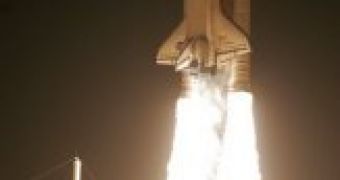It has been a busy day for the crew of Endeavor, as the inspection of the shuttle's heat shield was completed today, and everything seems to be in order. While they still have a lot to do in preparation for tomorrow's rendezvous with the International Space Station, back here on Earth, NASA has got itself into some kind of a puzzle. Cameras monitoring the launch of the orbiter reveal that about 10 seconds after the ignition of the engines, debris appear to fall from a region close to the shuttle's nose, leaving room for only one possible explanation. Something could have hit the nose during liftoff.
NASA engineers cannot be sure for now, as the images cannot clearly point towards the true origin of the debris or whether the original object hit or not the orbiter. Mike Moses, flight director at NASA, said: "It looks like it's not coming from the orbiter, and you can't really tell if it strikes the orbiter or not." Nonetheless, even if the debris had hit the shuttle's nose, it wouldn't have done too much damage, because the speed at which the vehicle was traveling was relatively small in that phase of the liftoff.
Pre-docking routine
Upon arriving into space, the seven astronauts of the STS-123 mission had only one day to adjust to the zero gravity environment, before beginning the inspection of the orbiter's protective heat shield. Comparison between the images taken before the launch and after revealed that the tiles of the heat shield were in good condition and prepared for the inevitable re-entry on March 26th.
The procedure became standard ever since the tragedy of Columbia space shuttle, when it disintegrated into Earth's atmosphere due to a gap in the heat shield, killing the crew in the process. "By tomorrow night we should have a real good idea about the state of the orbiter," said Moses.
Additionally, the crew executed an inspection of the spacesuits and activated one of the experiments carried by Endeavor, involving the study of how viruses behave in zero gravity environments. STS 123 has the mission to deliver the first component of the Kibo space laboratory and a robot built by Canada, to be mounted on outside the ISS for maintenance and repair purposes. During the assembly of the two major components, the crew on-board Endeavor will make five spacewalks over the span of 16 days, thus totaling about 30 hours of work outside the station.
Problems in flight
NASA also reports that, while in flight, Endeavor suffered two other minor malfunctions, one with the Flash Evaporator System and the second related to the Reaction Control System thrusters. The Flash Evaporator System is automatically activated 125 seconds after liftoff, and has the role of dissipating heat from the shuttle during orbital operations.
Most of the time, the task is carried out passively by simply opening the doors of the shuttle bay, and the FES is only used when heat capacity is exceeded, and during re-entry. The primary FES failed shortly after liftoff, however it was quickly replaced by the backup.
The RCS, on the other hand, handles the orbital maneuvering system and provides with pitch, yaw and roll controls while in orbit around Earth. Two of the rotational nozzles of the RCS failed upon activation due to a defective electronics card.

 14 DAY TRIAL //
14 DAY TRIAL //